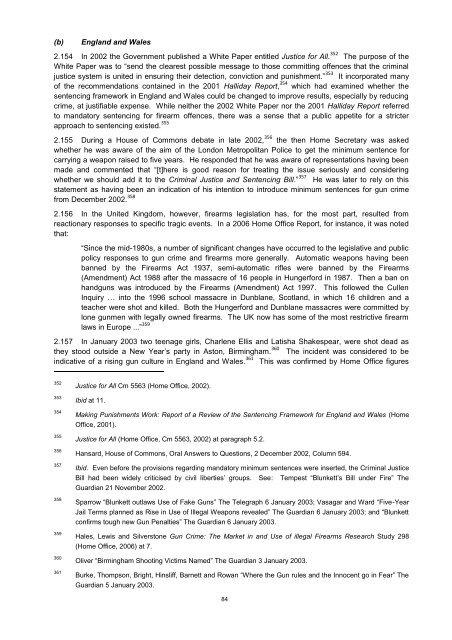Report on Mandatory Sentences - Law Reform Commission
Report on Mandatory Sentences - Law Reform Commission
Report on Mandatory Sentences - Law Reform Commission
You also want an ePaper? Increase the reach of your titles
YUMPU automatically turns print PDFs into web optimized ePapers that Google loves.
(b)<br />
England and Wales<br />
2.154 In 2002 the Government published a White Paper entitled Justice for All. 352 The purpose of the<br />
White Paper was to “send the clearest possible message to those committing offences that the criminal<br />
justice system is united in ensuring their detecti<strong>on</strong>, c<strong>on</strong>victi<strong>on</strong> and punishment.” 353 It incorporated many<br />
of the recommendati<strong>on</strong>s c<strong>on</strong>tained in the 2001 Halliday <str<strong>on</strong>g>Report</str<strong>on</strong>g>, 354 which had examined whether the<br />
sentencing framework in England and Wales could be changed to improve results, especially by reducing<br />
crime, at justifiable expense. While neither the 2002 White Paper nor the 2001 Halliday <str<strong>on</strong>g>Report</str<strong>on</strong>g> referred<br />
to mandatory sentencing for firearm offences, there was a sense that a public appetite for a stricter<br />
approach to sentencing existed. 355<br />
2.155 During a House of Comm<strong>on</strong>s debate in late 2002, 356 the then Home Secretary was asked<br />
whether he was aware of the aim of the L<strong>on</strong>d<strong>on</strong> Metropolitan Police to get the minimum sentence for<br />
carrying a weap<strong>on</strong> raised to five years. He resp<strong>on</strong>ded that he was aware of representati<strong>on</strong>s having been<br />
made and commented that “[t]here is good reas<strong>on</strong> for treating the issue seriously and c<strong>on</strong>sidering<br />
whether we should add it to the Criminal Justice and Sentencing Bill.” 357 He was later to rely <strong>on</strong> this<br />
statement as having been an indicati<strong>on</strong> of his intenti<strong>on</strong> to introduce minimum sentences for gun crime<br />
from December 2002. 358<br />
2.156 In the United Kingdom, however, firearms legislati<strong>on</strong> has, for the most part, resulted from<br />
reacti<strong>on</strong>ary resp<strong>on</strong>ses to specific tragic events. In a 2006 Home Office <str<strong>on</strong>g>Report</str<strong>on</strong>g>, for instance, it was noted<br />
that:<br />
“Since the mid-1980s, a number of significant changes have occurred to the legislative and public<br />
policy resp<strong>on</strong>ses to gun crime and firearms more generally. Automatic weap<strong>on</strong>s having been<br />
banned by the Firearms Act 1937, semi-automatic rifles were banned by the Firearms<br />
(Amendment) Act 1988 after the massacre of 16 people in Hungerford in 1987. Then a ban <strong>on</strong><br />
handguns was introduced by the Firearms (Amendment) Act 1997. This followed the Cullen<br />
Inquiry … into the 1996 school massacre in Dunblane, Scotland, in which 16 children and a<br />
teacher were shot and killed. Both the Hungerford and Dunblane massacres were committed by<br />
l<strong>on</strong>e gunmen with legally owned firearms. The UK now has some of the most restrictive firearm<br />
laws in Europe ...” 359<br />
2.157 In January 2003 two teenage girls, Charlene Ellis and Latisha Shakespear, were shot dead as<br />
they stood outside a New Year’s party in Ast<strong>on</strong>, Birmingham. 360 The incident was c<strong>on</strong>sidered to be<br />
indicative of a rising gun culture in England and Wales. 361 This was c<strong>on</strong>firmed by Home Office figures<br />
352<br />
353<br />
354<br />
355<br />
356<br />
357<br />
358<br />
359<br />
360<br />
361<br />
Justice for All Cm 5563 (Home Office, 2002).<br />
Ibid at 11.<br />
Making Punishments Work: <str<strong>on</strong>g>Report</str<strong>on</strong>g> of a Review of the Sentencing Framework for England and Wales (Home<br />
Office, 2001).<br />
Justice for All (Home Office, Cm 5563, 2002) at paragraph 5.2.<br />
Hansard, House of Comm<strong>on</strong>s, Oral Answers to Questi<strong>on</strong>s, 2 December 2002, Column 594.<br />
Ibid. Even before the provisi<strong>on</strong>s regarding mandatory minimum sentences were inserted, the Criminal Justice<br />
Bill had been widely criticised by civil liberties’ groups. See: Tempest “Blunkett’s Bill under Fire” The<br />
Guardian 21 November 2002.<br />
Sparrow “Blunkett outlaws Use of Fake Guns” The Telegraph 6 January 2003; Vasagar and Ward “Five-Year<br />
Jail Terms planned as Rise in Use of Illegal Weap<strong>on</strong>s revealed” The Guardian 6 January 2003; and “Blunkett<br />
c<strong>on</strong>firms tough new Gun Penalties” The Guardian 6 January 2003.<br />
Hales, Lewis and Silverst<strong>on</strong>e Gun Crime: The Market in and Use of illegal Firearms Research Study 298<br />
(Home Office, 2006) at 7.<br />
Oliver “Birmingham Shooting Victims Named” The Guardian 3 January 2003.<br />
Burke, Thomps<strong>on</strong>, Bright, Hinsliff, Barnett and Rowan “Where the Gun rules and the Innocent go in Fear” The<br />
Guardian 5 January 2003.<br />
84
















